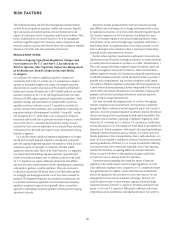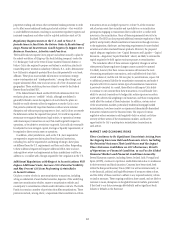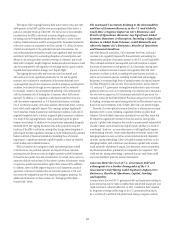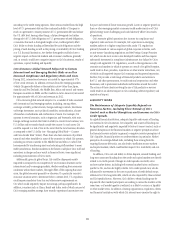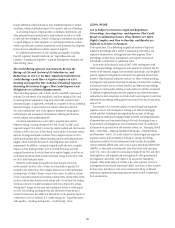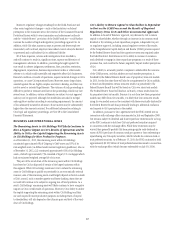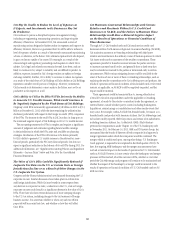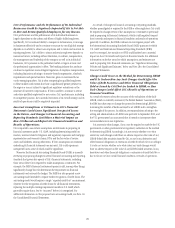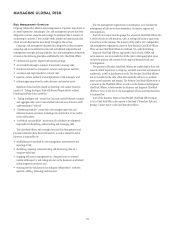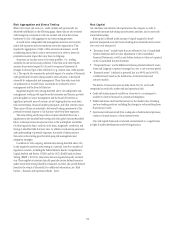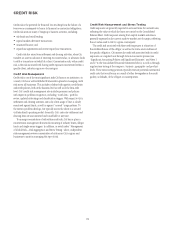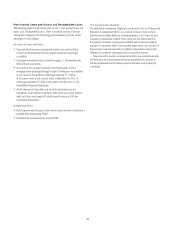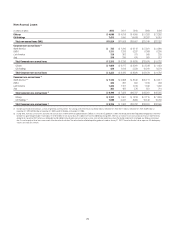Citibank 2012 Annual Report Download - page 92
Download and view the complete annual report
Please find page 92 of the 2012 Citibank annual report below. You can navigate through the pages in the report by either clicking on the pages listed below, or by using the keyword search tool below to find specific information within the annual report.70
Citi’s Performance and the Performance of Its Individual
Businesses Could Be Negatively Impacted If Citi Is Not Able
to Hire and Retain Qualified Employees for Any Reason.
Citi’s performance and the performance of its individual businesses is
largely dependent on the talents and efforts of highly skilled employees.
Specifically, Citi’s continued ability to compete in its businesses, to manage
its businesses effectively and to continue to execute its overall global strategy
depends on its ability to attract new employees and to retain and motivate its
existing employees. Citi’s ability to attract and retain employees depends on
numerous factors, including without limitation, its culture, compensation,
the management and leadership of the company as well as its individual
businesses, Citi’s presence in the particular market or region at issue and
the professional opportunities it offers. The banking industry has and may
continue to experience more stringent regulation of employee compensation,
including limitations relating to incentive-based compensation, clawback
requirements and special taxation. Moreover, given its continued focus
on the emerging markets, Citi is often competing for qualified employees
in these markets with entities that have a significantly greater presence in
the region or are not subject to significant regulatory restrictions on the
structure of incentive compensation. If Citi is unable to continue to attract
and retain qualified employees for any reason, Citi’s performance, including
its competitive position, the successful execution of its overall strategy and its
results of operations could be negatively impacted.
Incorrect Assumptions or Estimates in Citi’s Financial
Statements Could Cause Significant Unexpected Losses
in the Future, and Changes to Financial Accounting and
Reporting Standards Could Have a Material Impact on
How Citi Records and Reports Its Financial Condition and
Results of Operations.
Citi is required to use certain assumptions and estimates in preparing its
financial statements under U.S. GAAP, including determining credit loss
reserves, reserves related to litigation and regulatory exposures and mortgage
representation and warranty claims, DTAs and the fair value of certain
assets and liabilities, among other items. If Citi’s assumptions or estimates
underlying its financial statements are incorrect, Citi could experience
unexpected losses, some of which could be significant.
Moreover, the Financial Accounting Standards Board (FASB) is currently
reviewing or proposing changes to several financial accounting and reporting
standards that govern key aspects of Citi’s financial statements, including
those areas where Citi is required to make assumptions or estimates. For
example, the FASB’s financial instruments project could, among other things,
significantly change how Citi determines the impairment on financial
instruments and accounts for hedges. The FASB has also proposed a new
accounting model intended to require earlier recognition of credit losses. The
accounting model would require a single “expected credit loss” measurement
objective for the recognition of credit losses for all financial instruments,
replacing the multiple existing impairment models in U.S. GAAP, which
generally require that a loss be “incurred” before it is recognized. For
additional information on this proposed new accounting model, see Note 1 to
the Consolidated Financial Statements.
As a result of changes to financial accounting or reporting standards,
whether promulgated or required by the FASB or other regulators, Citi could
be required to change certain of the assumptions or estimates it previously
used in preparing its financial statements, which could negatively impact
how it records and reports its financial condition and results of operations
generally. In addition, the FASB continues its convergence project with
the International Accounting Standards Board (IASB) pursuant to which
U.S. GAAP and International Financial Reporting Standards (IFRS)
may be converged. Any transition to IFRS could further have a material
impact on how Citi records and reports its financial results. For additional
information on the key areas for which assumptions and estimates are
used in preparing Citi’s financial statements, see “Significant Accounting
Policies and Significant Estimates” below and Note 28 to the Consolidated
Financial Statements.
Changes Could Occur in the Method for Determining LIBOR
and It Is Unclear How Any Such Changes Could Affect the
Value of Debt Securities and Other Financial Obligations
Held or Issued by Citi That Are Linked to LIBOR, or How
Such Changes Could Affect Citi’s Results of Operations or
Financial Condition.
As a result of concerns about the accuracy of the calculation of the daily
LIBOR, which is currently overseen by the British Bankers’ Association (BBA),
the BBA has taken steps to change the process for determining LIBOR by
increasing the number of banks surveyed to set LIBOR and to strengthen
the oversight of the process. In addition, recommendations relating to the
setting and administration of LIBOR were put forth in September 2012, and
the U.K. government has announced that it intends to incorporate these
recommendations in new legislation.
It is uncertain what changes, if any, may be required or made by the U.K.
government or other governmental or regulatory authorities in the method
for determining LIBOR. Accordingly, it is not certain whether or to what
extent any such changes could have an adverse impact on the value of any
LIBOR-linked debt securities issued by Citi, or any loans, derivatives and
other financial obligations or extensions of credit for which Citi is an obligor.
It is also not certain whether or to what extent any such changes would
have an adverse impact on the value of any LIBOR-linked securities, loans,
derivatives and other financial obligations or extensions of credit held by or
due to Citi or on Citi’s overall financial condition or results of operations.


